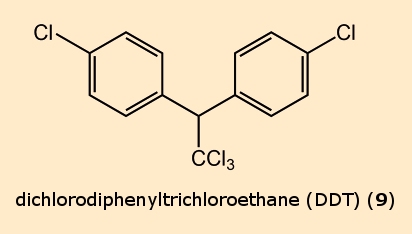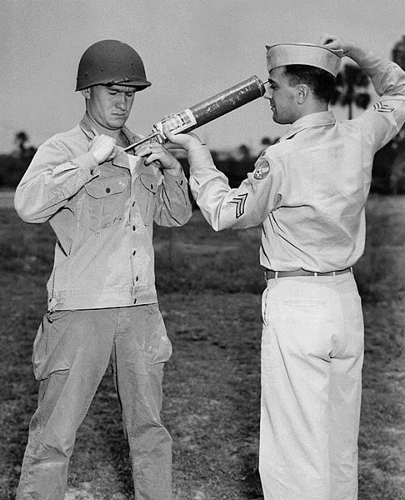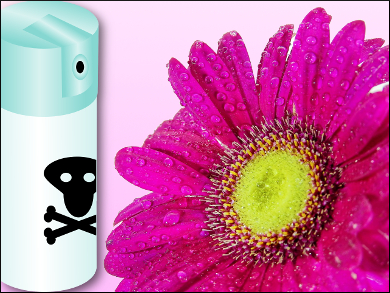Dried, pulverized flower heads of two chrysanthemum species (also known as “pyrethrum”) contain insecticides with nearly perfect toxicity profiles: highly toxic with respect to insects, but non-toxic to mammals. In this part, we compare the insecticidal activity of pyrethrins and DDT (dichlorodiphenyltrichloroethane).
9. DDT Conquers the Insecticide Market
The discovery of DDT (see Fig. 8) in the fall of 1939 revolutionized the insecticide market and had a long-lasting effect. The chemist Paul Müller (1899–1965) of the J. R. Geigy AG research laboratory in Basel, Switzerland, was in search of new moth-proofing agents, and in this context, he tested hundreds of chlorine-containing compounds. One of these was dichlorodiphenyltrichloroethane, DDT (9) [31], a material that had already been described in 1874. Nevertheless, Müller was the first to recognize its insecticidal properties.
 |
|
Figure 8. DDT. |
DDT turned out to be an extremely potent insecticide, which was soon marketed under the name Gesarol in the agricultural and livestock industries, and as the household insecticide Neozid. It proved to be an unprecedented success, economically for Geigy and scientifically for Paul Müller, who was honored “for his discovery of the high efficiency of DDT as a contact poison against several arthropods” with the Nobel Prize for Physiology and Medicine in 1948.
At the end of 1942, the US military decided to replace pyrethrins in their lice powder with DDT to increase the shelf life (see Fig. 9). The first performance test took place during the winter of 1943/44 in Naples, Italy. Before their withdrawal, German troops had destroyed the Naples municipal drinking water system, leading to catastrophic hygienic conditions in this city overflowing with refugees. An epidemic of typhus soon broke out, transmitted by clothes lice [32]. Paramedics among the American troops who moved into Naples in October of 1943 began immediately to train Italian assistants who, for a daily wage of 80 lira, commenced at once to spray everyone they could catch in the city with lice powder. Over a million people were subjected to this treatment. In the end, it proved an epochal triumph in that, for the very first time, a typhus epidemic was successfully terminated in the middle of winter.
 |
|
Figure 9. Combatting lice with DDT. (Source: Public Health Image Library) |
Although at the beginning of this delousing action, normal MYL-lice powder based entirely on pyrethrum was used exclusively, and DDT was only later introduced, euphoric media reports at the time attributed the phenomenal success exclusively to the latter [33,34].
10. Pyrethrins vs. DDT
According to Max Hollrung (1858–1937), the first university professor in Germany in the field of crop protection, the definitive characteristics associated with an ideal insecticide [35] were:
- high toxicity with respect to pests,
- fast acting,
- effective over a long period of time,
- as easy as possible to administer,
- not harmful to plants in general, to livestock, or to people, and
- producible at a low cost.
In subsequent editions of his book containing this list (published originally in 1898), the last criterion was expanded to require that an ideal insecticide could also be prepared from domestic raw materials. In later editions of this seminal work, published in 1914 and 1923, the list of requirements was modified slightly, and the list itself was eventually incorporated by Paul Müller into his Nobel Prize Address [36], though without any source attribution. In the meantime, this classic formulation of a catalog of requirements has erroneously been credited exclusively to Müller himself.
Comparing the characteristics of pyrethrins with those of DDT in terms of the above criteria:
Criteria 1 and 5
One measure of the comparative safety of an insecticide is a ratio of LD50‐values determined in terms of insects and mammals. Here, the pyrethrins exceed nearly all other insecticides, with values over 2000. Nevertheless, it must be noted that DDT, with an LD50 (rats, oral) of only 113 mg/kg body weight, is not highly toxic. Extrapolated to a human weighing 70 kg (154 lb), that value would correspond to a single dose of 8 g.
Criterion 2
Pyrethrins act with lightning speed. Mere seconds after the first contact, insects experience states of excitation, with cramps as well as severe coordination disturbances, and shortly thereafter, a complete inability to move (“knock-down” effect). Such insects soon flounder on their backs, and their number appears to be up.
Nevertheless, a significant number of the insects recover, so that after a few hours they scramble around again. The cause of this is a rapid decay of pyrethrins within the insects. In contrast, the action of DDT is delayed (no knock-down effect), but is nonetheless ultimately fatal.
Criterion 3
Pyrethrins show little stability. After exposure to open air, their half-lives (with respect to sunlight and air itself) are of the order of only a few hours. DDT, on the other hand, is noted for extreme long-term stability.
Criterion 4
Both pyrethrins and DDT are easy to handle.
Criterion 5
Evaluation of the harmlessness relative to plants, animals, and humans was at the time established exclusively on the basis of acute toxicity. Accordingly, both pyrethrins and DDT were considered harmless. But long-term consequences of massive application in the environment had not yet become a consideration.
Criterion 6
Given that they were in all cases natural products, the import-dependent pyrethrins were significantly more expensive than DDT, which could easily be prepared locally on an industrial scale. An additional advantage of DDT was that its synthesis required only domestic raw materials.
Taken Altogether …
Relative to DDT, the pyrethrins had little chance. Nevertheless, they did have the advantage when a rapid “knock-down” effect was desired. Also, for application directly on the human body, as in cases of scabies mites or lice, the limited stability of pyrethrins was, in a sense, advantageous. For this reason, agents directed toward head-lice infestations even today often still contain pyrethrins from plant sources as an important active ingredient. For household purposes, however, longer-lasting effects are more desirable in many applications. It is neither practical nor desirable to renew the moth-proofing of woolen carpets, or of wool garments in a wardrobe, on a daily basis. In such cases, the stability of DDT was simply unbeatable.
Against the background of today’s knowledge regarding consequences of the development of resistance, and of massive interventions in complex ecosystems, the enthusiasm for DDT immediately after World War II can only be comprehended by visualizing the drastic living conditions during the war and those postwar years. The initial successes achieved with DDT as an agricultural pesticide were truly impressive, and desperately needed in view of the waves of refugees flooding Europe—together with the miserable state of food supplies available in bombed-out cities everywhere. Introduced to ward off epidemics, DDT also freed entire countries from malaria, including Italy, Greece, Spain, Portugal, Hungary, Pakistan, Ceylon, and Taiwan.
To illustrate the amazing effects of DDT, at first regarded universally as a panacea, Gunnar Fischer of the Royal Karolinska Institute, Stockholm, Sweden, in awarding the 1948 Nobel Prize for Medicine and Physiology to Paul Müller, shared the following:
“A little story illustrates perhaps better than many words how the substance behaved. In 1945, when DDT had still not been tested very extensively, I encountered a British major in occupied Germany who told me how he had treated the window in his office with DDT because he was plagued with countless flies. After the solution had been sprayed on the panes, the flies promptly died and lay in piles on the window sill. The next morning, a German soldier carefully cleaned the now cloudy window panes. As the British major saw this he couldn’t contain himself, and moaned, ‘Goodbye my DDT!’ But this farewell turned out to be premature. Despite a thorough cleaning, the panes retained their deadly effect with respect to flies. This little tale illustrates in an impressive way how durably DDT works, and what small amounts are sufficient.”
References
[31] O. Zeidler, I. Verbindungen von Chloral mit Brom‐ und Chlorbenzol (in German), Ber. Deutsch. Chem. Ges. 1874, 1180. https://doi.org/10.1002/cber.18740070278
[32] Huntley Film Archives, Naples Typhus outbreak 1944. Archive film 92122, youtube.com 2014. (accessed July 2018)
[33] F. L. Soper et al., Typhus fever in Italy, 1943-1945, and its control with louse powder, Am. J. Hyg. 1947, 45, 305–334. https://doi.org/10.1093/oxfordjournals.aje.a119139
[34] D. H. Stapleton, A lost chapter in the early history of DDT: the development of anti-typhus technologies by the Rockefeller Foundation’s Louse Laboratory, 1942–1944, Technol. Cult. 2005, 46, 513–540. https://www.jstor.org/stable/40060902
[35] M. Hollrung, Handbuch der chemischen Mittel gegen Pflanzenkrankheiten: Herstellung und Anwendung im Grossen (in German), Verlagsbuchhandlung Paul Parey, Berlin, Germany, 1898.
[36] Paul Müller, Nobel Lecture, Nobel Lectures, Physiology or Medicine 1942–1962, Elsevier Publishing Company, Amsterdam, 1964.
The article has been published in German as:
- Von Insekten, Chrysanthemen und Menschen,
Klaus Roth, Elisabeth Vaupel,
Chem. unserer Zeit 2017, 51, 162–184.
https://doi.org/10.1002/ciuz.201700786
and was translated by W. E. Russey.
Pyrethrum: History of a Bio-Insecticide – Part 1
Chrysanthemum flowers as an insecticide
Pyrethrum: History of a Bio-Insecticide – Part 2
The chemical structures of pyrethrins and insecticide use between the World Wars
Pyrethrum: History of a Bio-Insecticide – Part 3
Comparing the insecticidal activity of DDT and pyrethrins
Pyrethrum: History of a Bio-Insecticide – Part 4
The comeback of pyrethrin research
Pyrethrum: History of a Bio-Insecticide – Part 5
The fall of DDT and the rise of pyrethrin derivatives
Pyrethrum: History of a Bio-Insecticide – Part 6
How pyrethrins kill insects
See similar articles by Klaus Roth published in ChemistryViews Magazine




